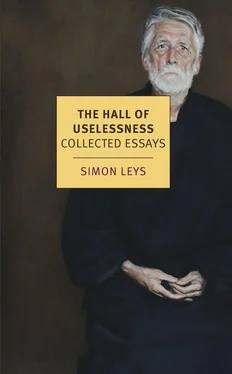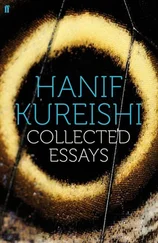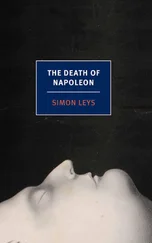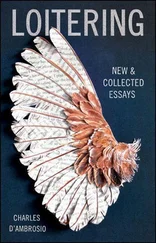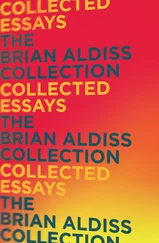Parallel couplets not only form the central core of all “regular poems” ( lü shi ), they are also constantly used in all other prosodic forms and can even be produced as independent units. Schematically they are comprised of two symmetrical verses; in each verse, every word possesses the same morphological status and performs the same grammatical function as its symmetric word in the other verse; whereas, in meaning, they are either similar or, better, antithetical — which fully achieves their mirror effect. Hence, a full enjoyment of a perfect couplet supposes a double reading — both vertical and horizontal. For instance, in a classic example from Du Fu (712–770),
Cicadas’ voices gather in the old monastery
Birds’ shadows fly over the cold pond
morphological and syntactical correspondences are rigorously observed between the two lines, so as to turn each verse into a perfect match for the other. Moreover, the interplay of the parallelisms enables us not only to read the lines vertically but also to read them across : in this way, the “cicadas’ voices” echo the “birds’ shadows,” “cold” prolongs “old,” and the “monastery” is reflected in the “pond.” From the first line to the second there is no logical sequence nor rational progression; what we observe here is not the linear unfolding of a discursive exposé but the circular coiling up of two contrasting images — non-successive, simultaneous, closely imbricated into one another. Unlike the discursive mode of expression that forges ahead and develops in time, the parallel mode suspends the time flow and winds upon itself. There is no anteriority or posteriority between the two images: they are both autonomous and tightly welded together, like the two sides of the same coin. In a formally perfect couplet, it should even be possible to read the second sentence before the first without affecting the meaning (this possibility is well illustrated by the habit, in Chinese interiors, of hanging parallel sentences on both sides of a painting or of any other central ornament). They do not develop a discourse — together they organise a space.
The use of parallel sentences is not the only means by which the Chinese poetic language is brought close to pictorial expression. In a more general and fundamental fashion, the entire poem can turn into a pure juxtaposition of images. It is precisely this aspect of the Chinese art of poetry which, at the beginning of the twentieth century, fascinated Western poets, Ezra Pound in particular, and was to exert a significant influence on modern English poetry.
Some sinologists who know much and understand little have laughed at Pound’s translations from classical Chinese. It is true that Pound knew very little Chinese and his translations are full of absurd mistakes. And yet, the fact that several excellent Chinese scholars have come to his defence should make us ponder: Pound’s transpositions may be philologically preposterous, but they often achieve a structure and rhythm that are much closer to the original Chinese than are most scholarly attempts.[7]
Pound had a mistaken idea of the Chinese language, but his mistake was remarkably stimulating and fecund, as it was based on one important and accurate intuition. Pound correctly observed that a Chinese poem is not articulated upon a continuous, discursive thread, but that it flashes a discontinuous series of images (not unlike the successive frames of a film). Where he went astray was in seeking to explain the imagist properties of the Chinese poetical language by the alleged pictographic nature of Chinese writing. Actually, as any beginner learns after a couple of lessons, most Chinese characters are not “tiny pictures”— stricto sensu pictographs represent barely 1 per cent of the Chinese lexicon — and yet the strange thing is that Pound never shed this mistaken notion; it inspired some of his most bizarre and unfortunate interpretations.
Actually, the real reasons that explain the imagist character of Chinese poetry, the factors that enable Chinese poets to deliver directly a series of perceptions without having to pass through the channels of grammatically organised discourse, pertain to two specific features of classical Chinese: morphological fluidity (the same word can be a noun or a verb or an adjective, according to the context) and, more importantly, syntactic flexibility (rules governing word order are reduced to a bare minimum; sentences can be without a verb; verbs can be without a subject; particles and grammatical trappings are practically non-existent).
Without venturing into the quicksands of linguistics, let us merely look at one or two examples. Wen Tingyun (818–872?) describes travellers departing before dawn in two famous verses that, translated word for word, read like this:
Roosters-sounds; thatch-inn; moon.
Man-footprint; plank-bridge; frost.
This collection of discontinuous and simultaneous perceptions, this series of scattered brushstrokes, can be reconstructed and interpreted in discursive language. We could say: “As one can still see the setting moon hanging over the thatched roof of the country inn, one hears roosters crowing everywhere. The travellers must have already left: their footprints are marked in the frost on the planks of the bridge.” The pictorial resources of classical Chinese free the poet from all such verbose detours and from the need to express logical connections; he does not explain, he does not narrate — he makes us see and feel directly. What he presents the reader with is not a statement but an actual experience.
The same phenomenon is also nicely illustrated by the much-admired beginning of a poem attributed to Ma Zhiyuan (end of the thirteenth century).
Dead ivy; old tree; dusk crows.
Little bridge; running creek; cottage.
Ancient path; west wind; lean horse…
(It should be observed, however, that the imagist approach is not the exclusive mode of Chinese poetry; discursive language also has a part to play. In fact, Chinese prosody is based upon a dialectical combination of these two modes, and this combination finds its most systematic and sophisticated expression in the form of the “regular poem” ( lü shi ). Nevertheless, it is true to say that the imagist language constitutes the major mode of Chinese poetry.[8])
We have just seen how Chinese poetry attempts to borrow channels that normally belong to pictorial expression. We shall now examine how painting adopts the status and methods of poetry.
* * *
At first contact, the physical outlook of a Chinese painting already betrays its literary nature. Western painting, crafted by artisans, has the heavy, stiff, massive and dumb presence of a piece of furniture: it hangs forever on its wall, gathering dust and fly droppings, awaiting a new coat of varnish every fifty years. Chinese painting, on the contrary, is mounted in the form of a scroll — which, historically, is related to the family of books. It genuinely belongs to the realm of the written word, as various expressions show: “to paint a painting” ( hua hua ) is a rather vulgar way of talking; the literate prefer to say: “to write a painting” ( xie hua ). The tools the writer needs — paper, ink and brush — are sufficient for a painter. The mounting of the painting — fragile, quivering at the faintest breeze — forbids permanent exhibition and only allows one to display the painting for the time of an active and conscious reading .
The highest type of pictorial style is called xie yi , which means the style that writes the meaning of things (instead of describing their appearances or shapes). The guiding principle for this form of painting is “to express the idea without the brush having to run its full course” ( yi da bi bu dao ). The ideal painting is achieved not on paper but in the mind of the spectator; for the painter, the whole skill consists in selecting those minimal visual clues that will allow the painting to reach its full and invisible blossoming in the viewer’s imagination. This point leads us into another theme: the active function of emptiness — the role played by “blanks” in painting, by silence in music, the poems that lie beyond words. We shall come back to this question later on.
Читать дальше
